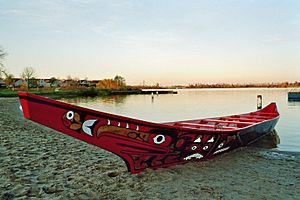Pacific Northwest canoes facts for kids
Canoes were super important boats for the Native people living along the Pacific Northwest coast of North America. These canoes came in many sizes and shapes. They were the main way people traveled for a very long time, even after Europeans arrived.
Today, people are making these traditional canoes again. Just like the old ones, these new canoes are very strong and great for traveling on the water.
Contents
How These Canoes Were Built
These amazing canoes were made by carving huge logs. The best wood for this was usually red cedar. Sometimes, people also used Sitka spruce or cottonwood trees.
After carving, the canoes were made wider than the original log. This was done by making the wood soft with steam. The canoemakers would pour hot water inside the canoe. They would also build fires outside. This steam and heat made the wood soft enough to spread the sides.
Spreading the sides did more than just make the canoe wider. It also changed the whole shape of the boat's body. The top edges, called gunwales, would curve smoothly outwards. The front (bow) and back (stern) parts would rise up. This turned a narrow, hollow log into a beautiful boat that could glide on the water.
To spread the wood without it cracking, the canoe walls had to be very thin. Once the carving was done, water was put inside. Red-hot rocks were added to make the water boil. Mats were used to cover the top, trapping the steam inside. The steam softened the wood from the inside. Fires outside helped heat the wood from the outside.
As the wood softened, the sides slowly moved outwards. The weight of the water and rocks inside also helped push them down. Workers then put spreading sticks between the gunwales. They slowly made these sticks longer, pushing the sides out even more. Once the canoe reached the perfect width and shape, it was allowed to cool. The water was removed. Then, cross-braces (thwarts), and blocks for the bow and stern were added. Caps were also fitted onto the gunwales.
Large canoes, used for travel or war, often had special paintings. These designs were linked to the canoe's name or the owner's family symbols.
What Were Canoes Used For?
These canoes were used for many things along the coast. People used them for traveling, trading goods, and sometimes for fighting as war canoes. They were also used for fishing and in exciting races.
Emily Carr, who grew up in Victoria, British Columbia, saw many canoe races. She said the Native races were the best part of any boat show. Canoes with ten paddlers and a steersman would "flash through their races like running fire." There was even a special race for women, called the Kloochman race. The women worked together perfectly, giving "every scrap of themselves to the canoe."
Big Canoes from the Past
The Haida from Haida Gwaii were known for making the biggest canoes. Some of these giant canoes were as long as 60 feet (18 meters)!
Modern Canoe Journeys
In 1937, Betty Lowman Carey became the first white woman to paddle alone. She traveled the Inside Passage of British Columbia in a dugout canoe.
Later, in 1978, Geordie Tocher and two friends made a long journey. They sailed a 40-foot (12-meter) dugout canoe, called the Orenda II. This canoe was made from Douglas fir and was based on Haida designs. It even had sails! They sailed from Vancouver, Canada, all the way to Hawaii. This trip helped show that the Haida might have traveled to Hawaii long ago. They traveled about 4,500 miles (7,242 km) over two months at sea.


